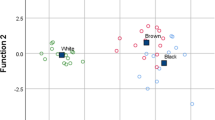Abstract.
Dominant black coat color in sheep is predicted to be caused by an allele E D at the extension locus. Recent studies have shown that this gene encodes the melanocyte stimulating hormone receptor (MC1-R). In mouse and fox, naturally occurring mutations in the coding region of MC1-R produce a constitutively activated receptor that switches the synthesis from phaeomelanin to eumelanin within the melanocyte, explaining the black coat color observed phenotypically. In the sheep, we have identified a Met→Lys mutation in position 73 (M73K) together with a Asp → Asn change at position 121 (D121N) showing complete cosegregation with dominant black coat color in a family lineage. Only the M73K mutation showed constitutive activation when introduced into the corresponding mouse receptor (mMC1-R) for pharmacological analysis; however, the position corresponding to D121 in the mouse receptor is required for high affinity ligand binding. The pharmacological profile of the M73K change is unique compared to the constitutively active E92K mutation in the sombre mouse and C123R mutation in the Alaska silver fox, indicating that the M73K change activates the receptor via a mechanism distinct from these previously characterized mutations.
Similar content being viewed by others
Author information
Authors and Affiliations
Additional information
Received: 18 September 1997 / Accepted: 14 October 1998
Rights and permissions
About this article
Cite this article
Våge, D., Klungland, H., Lu, D. et al. Molecular and pharmacological characterization of dominant black coat color in sheep. 10, 39–43 (1999). https://doi.org/10.1007/s003359900939
Issue Date:
DOI: https://doi.org/10.1007/s003359900939



